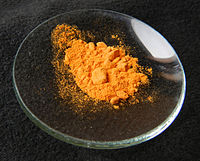- Hexamminecobalt(III) chloride
-
Hexamminecobalt(III) chloride 
 Hexaamminecobalt(III) chlorideOther namesCobalt hexammine chloride, hexaamminecobalt(III) chloride
Hexaamminecobalt(III) chlorideOther namesCobalt hexammine chloride, hexaamminecobalt(III) chlorideIdentifiers CAS number 10534-89-1 Properties Molecular formula H18N6Cl3Co Molar mass 267.48 g/mol Appearance yellow or orange crystals Density 1.71 g/cm3, Melting point decomposes
Solubility in water 0.26M (20 °C)
tribromide: 0.04M (18 °C)Solubility in other solvents soluble in NH3 Structure Coordination
geometryoctahedral Dipole moment 0 D Hazards R-phrases 36/37/38 S-phrases none Main hazards poison Related compounds Other anions [Co(NH3)6]Br3
[Co(NH3)6](OAc)3Other cations [Cr(NH3)6]Cl3
[Ni(NH3)6]Cl2Related compounds [Co(H2NCH2CH2NH2)3]Cl3
[Co(NH3)5(H2O)]Cl3
[Co(NH3)5Cl]Cl2 chloride (verify) (what is:
chloride (verify) (what is:  /
/ ?)
?)
Except where noted otherwise, data are given for materials in their standard state (at 25 °C, 100 kPa)Infobox references Hexamminecobalt(III) chloride is the chemical compound with the formula [Co(NH3)6]Cl3. This coordination compound is considered an archetypal "Werner complex", named after the pioneer of coordination chemistry, Alfred Werner. This salt consists of [Co(NH3)6]3+ trications with three Cl− anions. The term "ammine" refers to ammonia in its metal complexes, and the prefix hex (Greek: six) indicates that there are six ammonias per cation.
Originally this compound was described as a "luteo" (Latin: yellow) complex, but this name has been discarded as modern chemistry considers color less important than molecular structure. Other similar complexes also had color names, such as purpureo (Latin: purple) for a pentammine complex, and praseo (Greek: green) and violeo (Latin: violet) for two isomeric tetrammine complexes. [1]
Properties and structure
[Co(NH3)6]3+ is diamagnetic, with a low-spin octahedral Co(III) center. The cation obeys the 18-electron rule and is considered to be a classic example of an exchange inert metal complex. As a manifestation of its inertness, [Co(NH3)6]Cl3 can be recrystallized unchanged from concentrated hydrochloric acid: the NH3 is so tightly bound to the Co(III) centers that it does not dissociate to allow its protonation. In contrast, labile metal ammine complexes, such as [Ni(NH3)6]Cl2, react rapidly with acids reflecting the lability of the Ni(II)-NH3 bonds. Upon heating, hexamminecobalt(III) begins to lose some of its ammine ligands, eventually producing a stronger oxidant.
The chlorides in [Co(NH3)6]Cl3 can be exchanged with a variety of other anions such as nitrate, bromide, and iodide to afford the corresponding [Co(NH3)6]X3 derivative. Such salts are bright yellow and display varying degrees of water solubility.
Preparation
Since CoCl3 is not available, [Co(NH3)6]Cl3 is prepared from cobalt(II) chloride. The latter is treated with ammonia and ammonium chloride followed by oxidation. Oxidants include hydrogen peroxide or oxygen in the presence of charcoal catalyst.[2] This salt appears to have been first reported by Fremy.[3]
The acetate salt can be prepared by aerobic oxidation of cobalt(II) acetate, ammonium acetate, and ammonia in methanol.[4] The acetate salt is highly water-soluble to the level of 1.9M (20 °C), vs. 0.26M for the trichloride.
[Co(NH3)6]3+ is a component of some protein crystallization methods to help solve their structures by X-ray crystallography.
References
- ^ Huheey James E., "Inorganic Chemistry" (3rd edition 1983), p.360
- ^ Bjerrum, J.; McReynolds, J. P. (1946). "Hexamminecobalt(III) Salts". Inorg. Synth. 2: 216–221. doi:10.1002/9780470132333.ch69.
- ^ M. E. Fremy (1852). "Recherches sur le cobalt". Annales de chimie et de physique 35: 257–312. http://gallica.bnf.fr/ark:/12148/bpt6k34776q/f255.table.
- ^ Lindholm, R. D.; Bause, Daniel E. (1978). "Hexamminecobalt(III) Salts". Inorg. Synth. 18: 67–69. doi:10.1002/9780470132494.ch14.
Categories:- Cobalt compounds
- Inorganic compounds
- Chlorides
- Metal halides
- Coordination compounds
- Octahedral compounds
Wikimedia Foundation. 2010.
